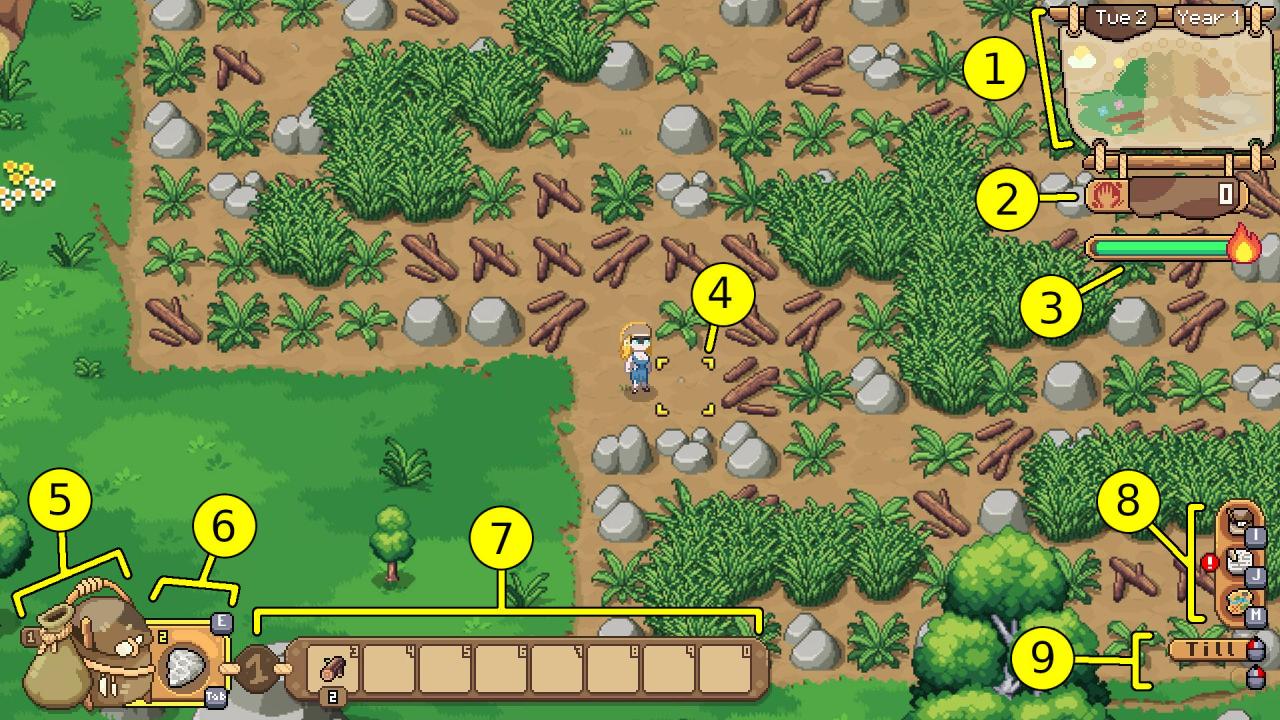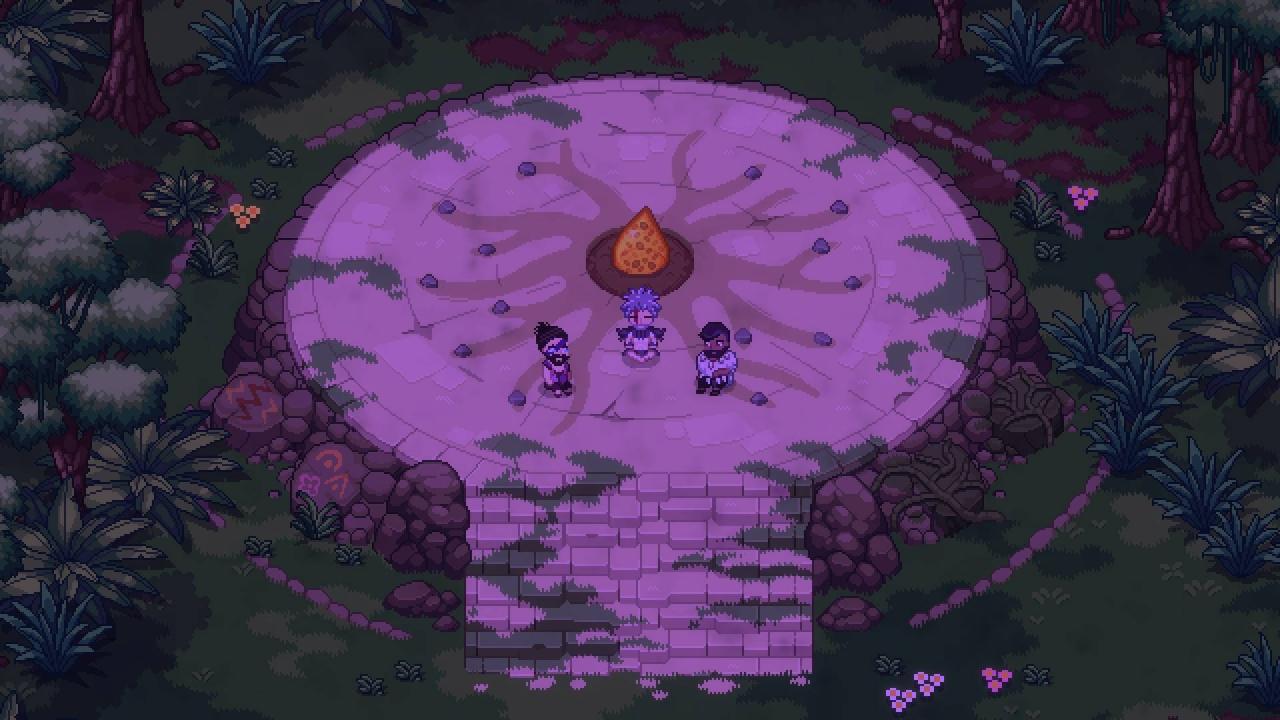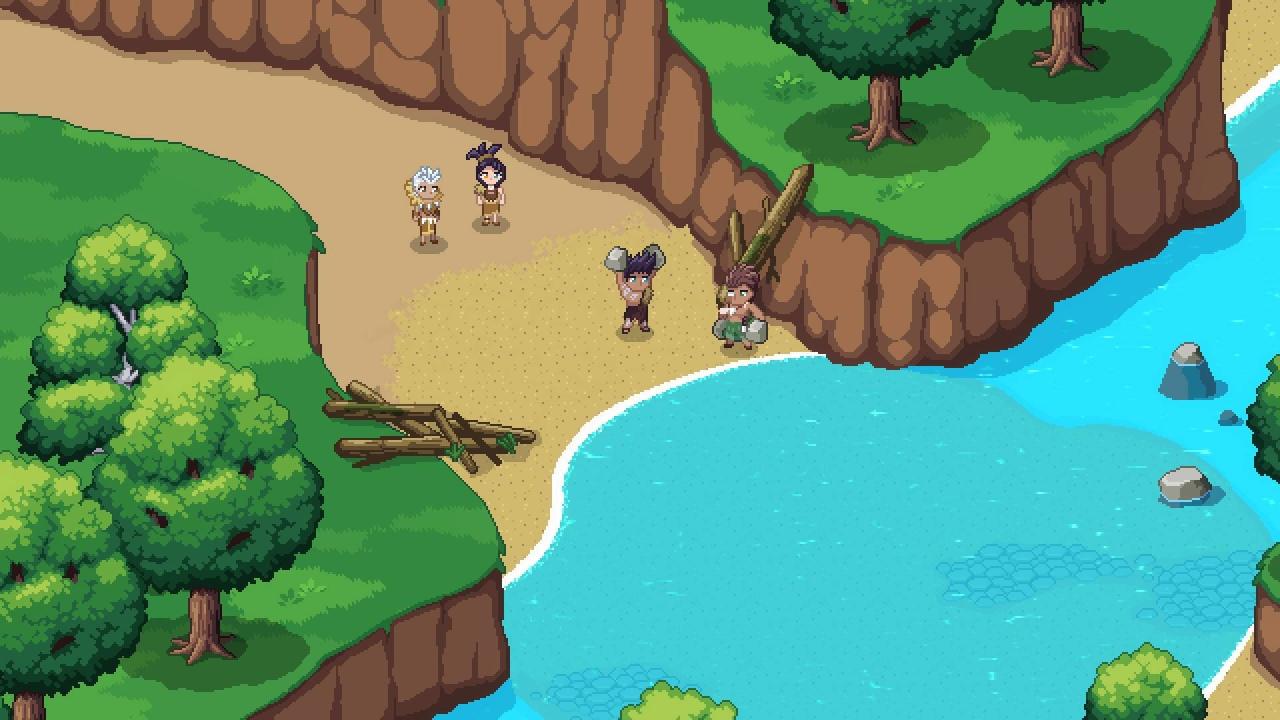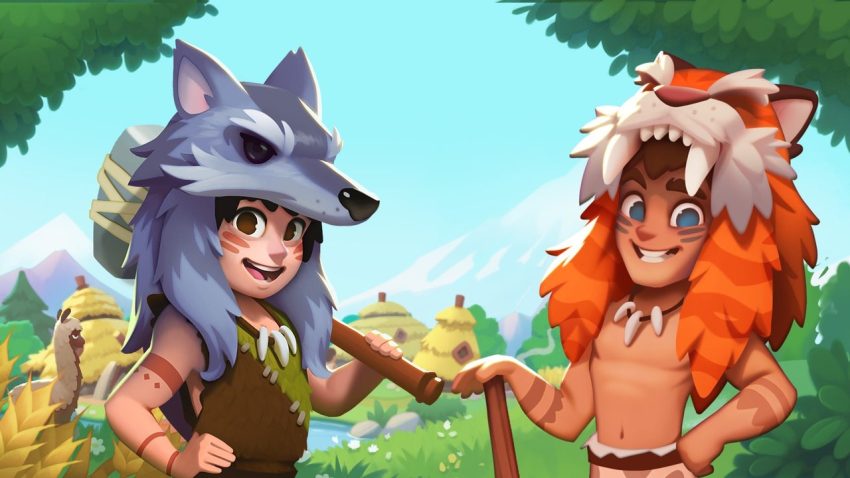Game Mechanics
We’ll kick off this Starter Guide with a breakdown of the basic game mechanics. Veterans of games like Stardew Valley will find many similarities, but there are key differences here, too.
Like most Farming RPGs, Roots of Pacha has an energy system represented by the “Stamina” bar. Performing actions such as watering Crops or chopping down a Tree will drain your Stamina, and eating Food will restore your Stamina. Unlike some games in the genre, there are no penalties for when your Stamina reaches 0 — you just won’t be able to do any work until you restore it with Food.
Roots of Pacha has a time and season system similar to many other games in the genre. There are 24 hours in a day, 7 days in a week, 4 weeks in a season, and 4 seasons in a year.
A day lasts 15 minutes in Roots of Pacha. The late-night warning takes place at 13:30. Your day begins at 6:00 AM in-game time, and the late-night cutoff is at 2:00 AM in-game time. If the clock reaches 2:00 AM (15 minutes of real-world time since you’ve woken up), you’ll pass out and begin the next day with reduced Stamina.
The game begins on Spring 1, Year 1, and an in-game year starts on Spring 1 and ends on Winter 28.
There is no money in Roots of Pacha, but there is an equivalent called “Contributions.” Contributions is a numerical representation of the work you’ve done that has helped the Clan. You earn Contributions by putting items in the sale bin.
Prosperity is kind of like a “score” for how well the Clan is doing. As Prosperity goes up, new things will be unlocked for the Clan and the Village. Your Contributions will directly add to Prosperity, and the Clan earns Prosperity on its own, too.
Roots of Pacha has a friendship and romance system. You can interact with people, give them gifts, and even get involved in a romantic relationship with certain people. You can give a maximum of 2 gifts per week.
Ideas are technological advancements that seem to be initially unlocked by reaching a certain point in time or performing a certain action. When you do, you’ll have to discuss the Idea with a Villager and provide them materials to research it. When they’ve finished researching the Idea, you’ll get access to something new such as a Workbench.
Prophecies are the in-game equivalent of achievements. Each Prophecy has four requirements. Once a Prophecy is completed, you’ll unlock a reward.
The Village can and will expand as time goes on. New devices that help the Clan and other amenities will be unlocked and available to Build over time, often as the result of a completed Idea. And yes, you’ll be able to get a Tent of your own, too.
Some Buildings cannot be placed everywhere. Certain Buildings (such as your personal Tent) can only be placed in certain pre-determined spaces surrounding the Village.
Tools
It should come as no surprise that Tools are an important part of the Farming RPG Roots of Pacha. Here’s a breakdown of the Tools you’ll encounter in the first Spring:
- Handaxe – The Handaxe is used to cut grass, break stones, chop wood, cut down some trees, till the earth, and even for Fishing. While it is good at many things, it is a poor tool for more specialized work (such as chopping down Hardwood trees). Unlocked by default.
- Waterskin – The Waterskin is used for watering tilled soil for Crops. It can till 1 square at a time and it has a capacity of 10 Water.
Torch – The Torch provides light at night. It never runs out. - Flute – The Flute can be used to tame Animals. You’ll unlock it after completing a specific Idea in the early game.
- Flint Axe – The Flint Axe is an upgrade for chopping down Trees; it gives you the ability to get Hardwood. You’ll need to find Flint and pay Acre to make it for you.
- Flint Hammer – The Flint Hammer is an upgrade for breaking rocks. It lets you destroy some of the tougher rocks in caves. You’ll have to get Flint and pay Acre to make it for you.
- Water Bucket – The Water Bucket is an upgrade for the Waterskin and replaces it. It increases the Water capacity to 20 and it can hydrate 3 squares of tilled soil at a time if you charge it up. You’ll need Hardwood to make this, so you should unlock the Flint Axe first.
These are just the initial Tools that you can get in the first couple of weeks of a new game. Better Tools will be made available as you progress through the game.
HUD Explanation

- Day, Date, and Time – The Day, Date, and Year are listed at the top. The Time is represented by the sun’s movement over the tree (and later, a proper clock). The Season is represented by the highlighted portion of the tree. From left to right: Spring, Summer, Fall, Winter.
- Contributions – This is essentially you’re money.
- Stamina – This is your Stamina meter. When it runs out, you can’t do work anymore.
- Tool Highlight – When working on the farm, a yellow square will appear to indicate where your tools will land.
- Seed Bag – This is where you store all of your Seeds. You can press Tab to cycle through all of your seeds, or you can press E to open it up and explore its contents.
- Tools – This is where all of your Tools are kept. Like the Seed Bag, you can press Tab to cycle through Tools and E to pick out a specific one.
- Hotbar / Belt – The Belt is your backpack. This is where you store items, food, etc.
- Inventory, Journal, and Map – This shows you the hotkeys for the Inventory, Journal, and Map, respectively. You can also click on these buttons.
- Button Actions – This area shows what would happen if you left-click or right-click with your cursor’s current placement.
It should be mentioned that 1 on the number row is dedicated to Seeds and 2 on the number row is dedicated to Tools. That means that your Hotbar/Belt actually begins with 3. Fans of Farming RPGs and similar games may need a little time to adjust to this unusual setup for the hotkeys.
Starter Guide Walkthrough
Now that you understand the basics of the game’s mechanics, let’s get moving with this Roots of Pacha Starter Guide Walkthrough! We’ll break down the major events of the first month and what you should do on those days.
The opening of the game begins with you returning from the mountains with your clan. After that, you’re let loose on the world out in front of your family home. Collect some Carrots in the area nearby, then head south and collect some Tomatoes.
Once you have your Seeds, go up to the very top of the field and clear some Grass, Rocks, and Sticks. Use your Handaxe to till the land, then plant all of your seeds. Switch to your Waterskin and water them.
You should still have some time left in the day, so spend it practicing Fishing in the nearby river. Don’t eat or sell any of the raw Fish; instead, you should save them for later. When you run out of energy, you can spend the rest of the day exploring and talking to people or you can immediately go to bed.

Spring 2 begins with The Rite of Passage — and your character is participating. After a short cutscene, you’ll be given four choices. Here’s what the choices are and what you’ll get in return.
Seeds that GROW QUICKLY into food we can harvest
- Plant Growth Speed +10
- Increases the growth rate of seeds you’ve planted. +10 from Rite of Passage.
A fish that I was LUCKY enough to catch
- Fish Catching +12
- Improves your chances to catch a fish. +12 from Rite of Passage.
A flower that blooms like FRIENDSHIP
- Charm +4
- Improves the way you relate with others. +4 from Rite of Passage.
A dish that gives us STAMINA for our day
- Max Stamina +20
- Increase your maximum Stamina. +20 from Rite of Passage
You can only pick one of these buffs, but it’s permanent. Carefully consider which one you’d like to take. Personally, I’m a fan of Max Stamina +20.
Once the Rite of Passage is over, you will get control of your character in the Forest. You can chat with some Villagers if you’d like to. When you’re ready to leave, walk away and you’ll be able to actually start your day (although you’ll start from the Forest instead of outside your home).
You can take this time to explore the Mountains and find some new seeds including Beans, Potatoes, and Quinoa. Take these back home, plant them, and water all of your seeds with your Waterskin. Use any remaining energy for Fishing.
Spring 3 will be the first “normal” day where nothing special really happens. This is a good time to establish your routine and think about how you’d like to play.
Any activity involving most resources will increase your “Knowledge” of that item which will give you bonuses. For example, planting and harvesting a Crop will give you better versions of that Crop. If you’re going to do Farming, it’s a good idea to focus on getting seeds as often as you can and growing as many as you can, especially in the first Spring.
Either way, do your daily chores and call it a day.
Spring 4 starts with a new surprise — the Caves at the top of the Forest have opened! You can now head inside and explore.
These Caves are where you’ll be able to get Flint, a necessary resource for upgrading your Tools. Check out our guide on how to get Flint for a detailed lesson on the subject!
Another normal day. Do whatever you like!
Spring 6 introduces a new “Idea” that will allow you to tame Animals. Find the person in question via your Journal, right-click on them, and select “Discuss Idea.” They’ll tell you what resources they need to research the idea. Provide them, and you’ll have something new to play with in the next few days. (In this case, it will be the Flute and the ability to tame Animals.)
This day also marks the beginning of a new bridge over to the Jungle. This is where you’ll be able to earn the bonuses from Prophecies once you’ve completed them.
The next day opens up the possibility of building your own home, should you choose to do so. Otherwise, it’s a normal day, so continue to Farm and Fish.
Spring 8 – The Jungle Opens
The 8th day begins at the Jungle Bridge after a cutscene. You can head into the Jungle if you’d like, but there isn’t much of interest there — not yet, anyway.
The Jungle is home to the altar where you’ll complete Prophecies. Completing Prophecies (which you can see in the menu) will give you tangible rewards, equipment, and buffs. Continue progressing through the game and you’ll inevitably complete some just through normal play.
Spring 9 to Spring 11
The next three days are normal days, so do whatever you’d like to.
Spring 12 – The Beach Opens
The twelfth day gives you access to a new area: the Beach. This also introduces three new people from a neighboring tribe: Krak, Brub, and Inza.
Your day will begin in the Pachan Hearth along with one of the newcomers. Otherwise, it’s a normal day.
Exploring the Beach is worthwhile. There’s good Fishing there, and you can also get a new Crop and some other items you can sell such as the Blue Seashell.
Spring 13
Spring 13 is another regular day, more or less.

Spring 14 – Enter the Savanna
This day marks the final major location opening: the Savanna. As with the Beach, you’ll meet members of another neighboring Clan: Touk, Vallah, and Zeda.
Your day starts by the Bonfire, but you’re not gonna want to stay there for long; the Savanna is massive and is worth exploring for new Seeds. Tend to your Crops, then go check it out!
Spring 15 and Beyond
With the Savanna opened, there are no more major areas to open up. You have a lot of possibilities open to you!
Your Clan has likely introduced some new Ideas for you to explore, allowing you to explore the possibilities of taming Animals, getting a Mount, or increasing your Seed production. You have the Totem Cave to explore in the Forest, too.
Summer is less than two weeks away. If you’ve unlocked the Plant Nursery, take care to save up some Contributions so you can buy Seeds at the start of the next season. And if you don’t have the Plant Nursery, you should definitely get it — it allows you to buy Seeds in exchange for Contributions.
